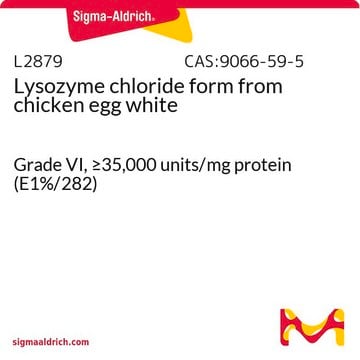10837059001
Roche
Lysozyme
from hen egg white
Synonym(s):
Mucopeptide N-acetylmuramoyl-hydrolase, Muramidase, lysozyme
Sign Into View Organizational & Contract Pricing
All Photos(1)
About This Item
Recommended Products
biological source
chicken egg white
Quality Level
Assay
≥95%
form
solid
specific activity
>23000 U/mg (Shugar units)
mol wt
14.4 kDa
packaging
pkg of 10 g
manufacturer/tradename
Roche
optimum pH
6.0-7.0
absorption
3.9 at 280 nm (10 mg enzyme/ml)
General description
Muramidase, Mucopeptide N-acetylmuramoyl-hydrolase
Application
Lysozyme has been used for:
- Cell wall degradation
- Preparation of protoplasts
- Bacteriolysis
- Pharmacology (anti-inflammatory effect on mucous membrane; healing of tissue; protection against bleeding; normalization of mucus secretion; dissolution of pyrogens; potentiation of antibiotics)
- Food and drinks (flavor enhancer)
- Sample preparation prior to isolation of nucleic acids
Lysozyme has been used in the monitoring of transcription by real-time -PCR and sample preparation.
Biochem/physiol Actions
Lysozyme hydrolytically cleaves the bonds between N-acetyl-D-glucosamine and N-acetylmuramic acid residues (GlcNAc β1-4Mur) in mucopolysaccharides and the glycan skeletons of the corresponding peptidoglycans (the latter are glycosaminoglycans linked to or crosslinked by peptide chains). Lysozyme effectively destroys the cell walls of bacteria.
Unit Definition
One Shugar unit is that quantity of enzyme in 1 ml of a suspension of Micrococcus luteus of pH 7.0 whose initial absorbance at a wavelength of 450 nm is 0.750 for a pathlength of 10 mm which causes the absorbance to decrease at the rate of 0.001 per minute, all measurements being carried out at a temperature of +25 °C.
Preparation Note
Working solution: Lysozyme hydrochloride is readily soluble in water and buffer solutions but insoluble in organic solvents.
Storage conditions (working solution): -15 to -25 °C
Aqueous solutions of the hydrochloride (2 mg/ml dist. water) can be stored for several days at 2 to 8° C or at -15 to -25° C for several weeks.
Storage conditions (working solution): -15 to -25 °C
Aqueous solutions of the hydrochloride (2 mg/ml dist. water) can be stored for several days at 2 to 8° C or at -15 to -25° C for several weeks.
Reconstitution
Prepare a stock solution at a concentration of 50 mg/ml in dist. water. Dispense into aliquots and store at -15 to -25 °C. Discard each aliquot after use.
Storage and Stability
Store at 2 to 8 °C. (Store dry!)
Other Notes
For life science research only. Not for use in diagnostic procedures.
Storage Class Code
11 - Combustible Solids
WGK
WGK 2
Flash Point(F)
does not flash
Flash Point(C)
does not flash
Certificates of Analysis (COA)
Search for Certificates of Analysis (COA) by entering the products Lot/Batch Number. Lot and Batch Numbers can be found on a product’s label following the words ‘Lot’ or ‘Batch’.
Already Own This Product?
Find documentation for the products that you have recently purchased in the Document Library.
Customers Also Viewed
Kimberly M Davis et al.
Infection and immunity, 79(2), 562-570 (2010-11-03)
Bacterial pathogens that colonize mucosal surfaces have acquired resistance to antimicrobials that are abundant at these sites. One of the main antimicrobials present on mucosal surfaces is lysozyme, a muramidase that hydrolyzes the peptidoglycan backbone of bacteria. Cleavage of the
A new iron acquisition system in Bacteroidetes.
Manfredi P, et al.
Infection and Immunity (2014)
Cloning and expression of metagenomic DNA in Streptomyces lividans and subsequent fermentation for optimized production
Yuriy R, et al.
Meta Gene (2017)
Blanca López-Méndez et al.
European biophysics journal : EBJ, 50(3-4), 411-427 (2021-04-22)
Microscale thermophoresis (MST), and the closely related Temperature Related Intensity Change (TRIC), are synonyms for a recently developed measurement technique in the field of biophysics to quantify biomolecular interactions, using the (capillary-based) NanoTemper Monolith and (multiwell plate-based) Dianthus instruments. Although
Lorena Hentschel et al.
Physical chemistry chemical physics : PCCP, 23(4), 2686-2696 (2021-01-23)
During a first-order phase transition, a thermodynamic system releases or absorbs latent heat. Despite their fundamental importance, the heat or enthalpy change occurring during protein crystallization has been directly measured only in a few cases, and the associated entropy change
Our team of scientists has experience in all areas of research including Life Science, Material Science, Chemical Synthesis, Chromatography, Analytical and many others.
Contact Technical Service




